
NGC 3504 is a barred spiral galaxy in the constellation Leo Minor. It has a Hubble distance corresponding to 88 million light-years and was discovered by William Herschel in 1785.

Arp 273 is a pair of interacting galaxies, 300 million light years away in the constellation Andromeda. It was first described in the Atlas of Peculiar Galaxies, compiled by Halton Arp in 1966. The larger of the spiral galaxies, known as UGC 1810, is about five times more massive than the smaller galaxy. It has a disc that is tidally distorted into a rose-like shape by the gravitational pull of the companion galaxy below it, known as UGC 1813. The smaller galaxy shows distinct signs of active star formation at its nucleus, and "it is thought that the smaller galaxy has actually passed through the larger one."
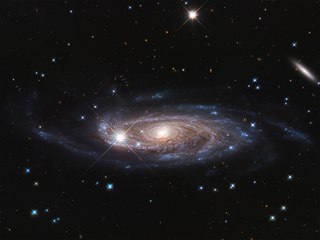
UGC 2885 is a large barred spiral galaxy of type SA(rs)c in the constellation Perseus. It is 232 million light-years (71 Mpc) from Earth and measures 463,000 ly (142,000 pc) across, making it one of the largest known spiral galaxies. It is also a possible member of the Pisces-Perseus supercluster.
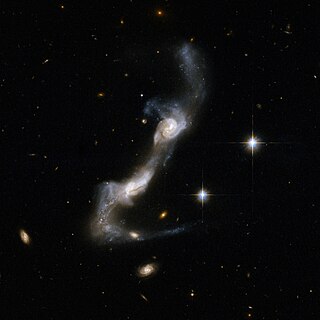
UGC 8335 is a pair of strongly interacting spiral galaxies. They have been distorted by extreme tidal forces, creating prominent tidal tails and a bridge of gas and stars between the galaxies.
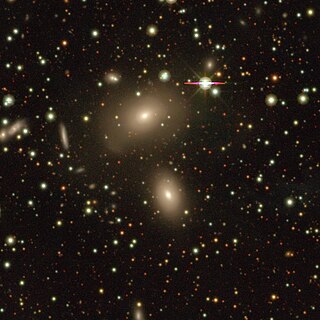
NGC 7033 is a lenticular galaxy located about 390 million light-years away in the constellation of Pegasus. It is part of a pair of galaxies that contains the nearby galaxy NGC 7034. NGC 7033 was discovered by astronomer Albert Marth on September 17, 1863.

NGC 521, also occasionally referred to as PGC 5190 or UGC 962, is a barred spiral galaxy located approximately 224 million light-years from the Solar System in the constellation Cetus. It was discovered on 8 October 1785 by astronomer William Herschel.

NGC 918 is a barred spiral galaxy in the constellation Aries, about 67 million light years from the Milky Way. It was discovered by John Herschel on Jan 11, 1831.
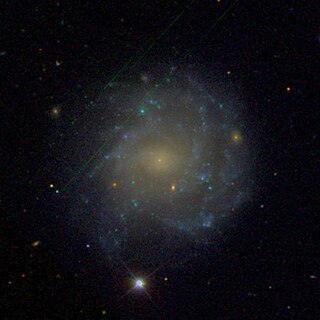
NGC 991 is an intermediate spiral galaxy the constellation Cetus. This galaxy was discovered by astronomer William Herschel in 1785.

NGC 767 is a barred spiral galaxy located in the constellation Cetus about 241 million light years from the Milky Way. It was discovered by the American astronomer Francis Leavenworth in 1886.

NGC 4589 is an elliptical galaxy located in the Draco constellation. It was discovered by German-British astronomer William Herschel on November 22, 1797. This galaxy lies at a distance of 73.0 million light-years (22.39 Mpc) from the Milky Way, and is receding with a heliocentric radial velocity of 2,002 km/s. It is known by its designations PGC 42139 or UGC 7797.

NGC 5910 is an elliptical galaxy located about 540 million light-years away in the constellation Serpens. It was discovered by astronomer William Hershel on April 13, 1785. NGC 5910 is also a strong radio source with a conspicuous nuclear jet.

UGC 934, known as PGC 5085, is a large spiral galaxy about 470 million light-years away from the solar system. It is located in the constellation of Pisces and about 285,000 thousand light-years in diameter.
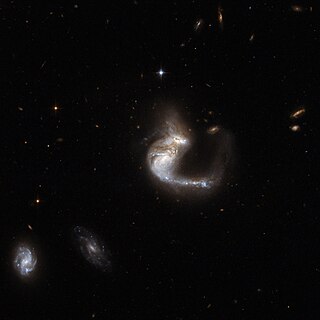
UGC 4881 is a pair of interacting galaxies, UGC 4881A and UGC 4881B. They are located in the constellation Lynx, some 500 million light-years away. UGC 4881, the brighter, is a peculiar spiral galaxy. It has been heavily documented by the Hubble Space Telescope, and is cataloged in the Atlas of Peculiar Galaxies.
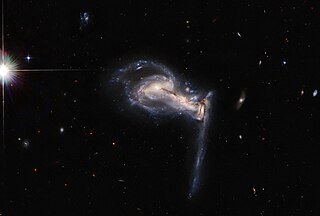
UGC 4653 known as Arp 195, is a trio of interacting galaxies located 763 million light-years away from the solar system in the Lynx constellation. The galaxies are being distorted through gravitational interactions with each other. The first known reference for this object, was in 1959 where B.A. Vorontsov-Vel'yaminov compiled it inside the Vorontsov-Vel'yaminov Interacting galaxies, as VV 243.

NGC 6261 is a lenticular galaxy in the constellation of Hercules. It is located 470 million light-years away from the Solar System and has an approximate diameter of 200,000 light-years.
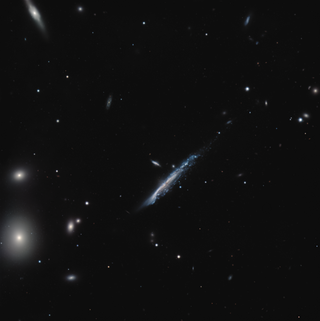
UGC 6697 is a large irregular spiral galaxy with a bar located in the Leo constellation. It is located 378 million light-years from the Solar System and has an estimated diameter of 205,000 light-years. UGC 6697 is considered a starburst galaxy which produces high rates of star formation. The first known reference to this galaxy comes from volume II of the Catalogue of Galaxies and of Clusters of Galaxies compiled by Fritz Zwicky in 1968, where it was listed as CGCG 097-087, and its coordinates listed as 1141.2 + 2015.
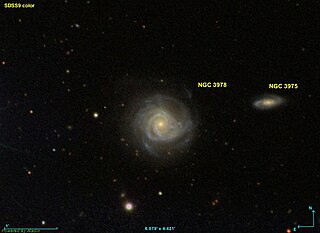
NGC 3978 is a large intermediate spiral galaxy with a bar located in the constellation of Ursa Major. It is located 460 million light-years away from the Solar System and was discovered by William Herschel on March 19, 1790, but also observed by John Herschel on April 14, 1831.

NGC 3447 is a barred Magellanic spiral galaxy located in the constellation Leo. Its speed relative to the cosmic microwave background is 1,405 ± 34 km/s, which corresponds to a Hubble distance of 20.7 ± 1.5 Mpc. It was discovered by the British astronomer John Herschel in 1836.

UGC 11861 is a barred spiral galaxy in the constellation of Cepheus. Its velocity with respect to the cosmic microwave background is 1334 ± 10 km/s, which corresponds to a Hubble distance of 19.68 ± 1.39 Mpc. In addition, three non redshift measurements give a distance of 18.933 ± 5.26 Mpc. The first known reference to this galaxy comes from volume IV of the Catalogue of Galaxies and of Clusters of Galaxies compiled by Fritz Zwicky in 1968, where it was listed as CGCG 343-003, and described as an "extremely diffuse spiral."



















